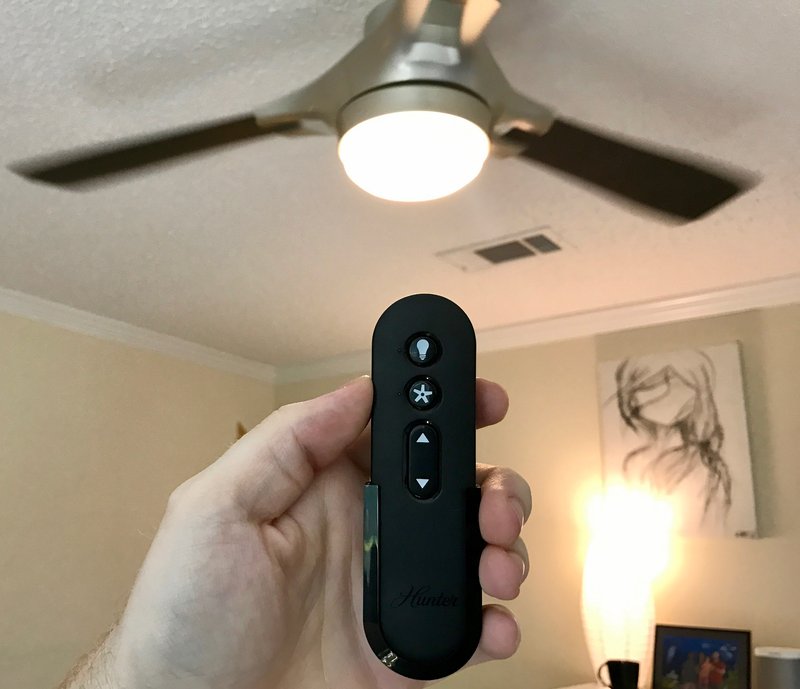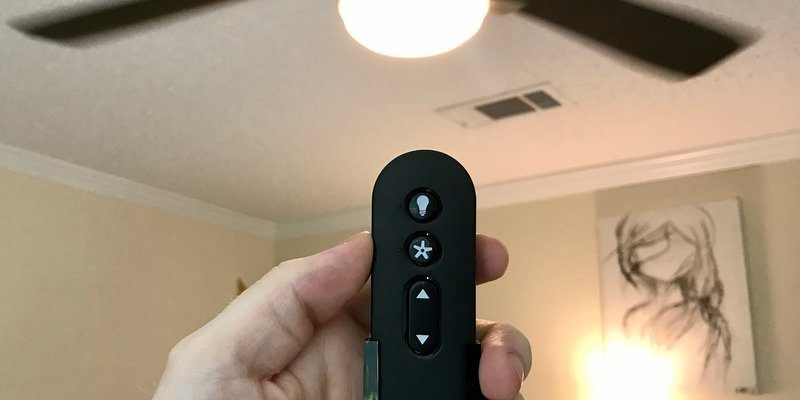
Picture your remote as a walkie-talkie for your fan—it sends little signals through the air, telling your ceiling fan what to do. These remotes are a nice upgrade from pull chains and wall switches, especially late at night. Hunter, a big name in ceiling fans, builds their remotes with comfort in mind, but every remote has its limits. Understanding those limits can save you from a lot of head-scratching and troubleshooting down the road.
Typical Range of a Hunter Ceiling Fan Remote
Here’s the thing: a Hunter ceiling fan remote usually works within a *range of 20 to 40 feet*. That’s about as far as a school bus is long, or roughly the distance between your sofa and the far end of a big living room. In most homes, this range easily covers a master bedroom, living room, or even an open-concept space without issue. But, that’s assuming there aren’t any obstacles in the way.
Hunter remotes send radio frequency (RF) signals—not infrared (IR), which needs a direct path—so you don’t have to point it straight at the fan. That’s handy if your coffee table is piled high or you’re aiming around a corner. But even with RF, thick walls, metal objects, or electronic interference can chip away at the effective range. It’s like trying to shout through a pillow; your voice gets muffled.
To make this real, imagine you’re standing in your hallway, trying to adjust the ceiling fan in your bedroom. If there are too many walls between you and the fan, the remote’s signal may just fizzle out. That’s where many folks start to wonder if their remote is broken, but usually, it’s just the signal hitting roadblocks.
What Affects the Range of Hunter Fan Remotes?
You might be wondering why the range varies so much. Remote signals can be surprisingly sensitive to their surroundings. Here’s why:
- Obstacles like walls and doors: Every wall or closed door adds resistance for that invisible signal. Concrete, brick, or metal are especially tough for remotes to penetrate.
- Electronic interference: WiFi routers, microwaves, and even other RF remotes can muddy the signal waters. If multiple devices are crowded into a small space, the remote might not stand a chance.
- Construction materials: If your fan is installed in a room with thick lath-and-plaster walls or metal studs, don’t be surprised if your range shrinks dramatically.
- Battery strength: Weak batteries lead to weak signals. Sometimes, swapping in a new battery instantly boosts the remote’s range.
Honestly, I’ve lost count of how many times fresh batteries fixed a “broken” remote. If you’re struggling with short range, check the battery first. Then, think about what’s physically between you and the fan. Sometimes, just stepping around a corner or opening a door can make all the difference.
Signals love open air. They hate thick walls, crowded electronics, and dead batteries.
How to Improve Hunter Ceiling Fan Remote Range
If your Hunter ceiling fan remote won’t work from your favorite spot on the couch, there are ways to stretch its range. Here’s what usually helps:
- Replace the batteries: It sounds simple, but low battery power is the most common culprit behind poor signal transmission.
- Minimize obstacles: Keep large metal objects or electronics out of the path between the remote and the fan. Even moving a lamp or TV receiver can help.
- Avoid interference: Don’t place WiFi routers or cordless phones near the ceiling fan receiver if you can help it. These can cause signal confusion.
- Re-sync the remote and receiver: Sometimes, the code between your remote and the fan can get lost. Resetting or pairing the remote again can restore normal range. (Check your Hunter manual for pairing steps—usually, it’s a matter of pressing a sync button on the fan and remote at the same time.)
- Test from different positions: Stand in various places around the room. Sometimes, just moving left or right a few feet clears up the signal path.
Let me tell you, it’s oddly satisfying when the remote suddenly responds from a spot that was dead before. If none of these steps help, the issue could be with the fan’s receiver, not the remote itself. At that point, troubleshooting or even a replacement might be needed.
Hunter Remote Control Codes, Pairing, and Resetting
You might not realize it, but your Hunter remote and fan are paired with a special digital “code.” This code keeps the neighbor’s remote from messing with your fan, but it also needs to be in sync for your remote to work at any distance.
Pairing the remote is usually easy. There’s often a tiny “learn” button inside the battery compartment or on the fan receiver. To sync them, you typically press and hold this button on both the fan and remote until a light flashes or the fan responds.
If the remote stops working out of the blue, it could have lost the code connection, especially after a power outage or battery change. Resetting the pairing is usually a quick fix. Just repeat the pairing process and you’ll be back in business. Don’t be afraid to check the Hunter manual for the exact steps—each model’s a bit different.
Sometimes, you’ll need to pair more than one remote to the same fan (say, one for each side of a big bedroom). Most Hunter fans support multiple remotes—just pair each one the same way. If you’re switching from an old remote to a new one, always unpair or reset to avoid mixed signals.
If your Hunter ceiling fan remote suddenly loses range, check the pairing or reset the sync. It’s like rebooting your WiFi—sometimes the simplest step fixes everything.
Comparing Hunter Remote Range to Universal Ceiling Fan Remotes
Here’s a question I hear a lot: “Should I just get a universal remote instead?” Universal ceiling fan remotes can be tempting, especially if you’ve lost your original or want extra features. But range-wise, they’re usually in the same ballpark—20 to 40 feet.
Some universal remotes claim longer range, but actual performance comes down to the same things: obstacles, interference, and battery quality. Plus, pairing a universal remote can be trickier, since you have to match the right code and make sure it’s speaking the fan’s language. Sometimes, compatibility bugs mean you end up troubleshooting even more.
If your Hunter brand remote works most places in your room, it’s usually best to stick with it. Universal remotes are handy for fans with lost or dead remotes, or when you want a single remote to control lights and fans together. But don’t expect a miracle boost in range just from switching brands.
Common Troubleshooting Steps for Hunter Fan Remotes
Let’s say you’re getting frustrated. Maybe your remote only works if you’re directly under the fan, or not at all. Here’s a basic troubleshooting checklist, in plain terms:
- Check the batteries first. Even if the indicator light glows, weak batteries can mean weak signals.
- Look for obvious obstacles. Furniture, TVs, or even fish tanks can block signals more than you think.
- Try pairing or resetting the remote. Use the process in your Hunter manual, or experiment—usually, it involves pressing and holding a button until the fan responds.
- Swap to a different remote. If you have more than one, see if a second remote works better. This helps rule out remote vs receiver issues.
- Check the fan’s receiver. If possible, make sure the receiver in the fan’s housing is powered and hasn’t come loose (turn off the power before poking around!).
If nothing works, it could be time to call in a pro or look at replacing either the remote or the receiver. Don’t feel bad—these little gadgets have a shelf life, and sometimes they just give up.
Hunter Remote Range in Different Home Setups
A Hunter ceiling fan remote will behave differently in different houses. In a wide-open living room with a clear line to the fan, you’ll probably get the maximum range. But in a home with thick walls, lots of metal shelving, or a tangle of electronics, you might find the range is cut in half.
Let’s say your fan is in a bedroom, and you want to control it from the hallway. If the door’s open and the wall’s drywall, no problem. But switch that to a closed door or a wall of built-in cabinets, and suddenly you’re out of luck. Basements with brick or concrete block walls? Don’t expect full range there either.
Older homes with lath and plaster or steel reinforcements can also eat up wireless signals. Newer builds tend to be easier on remotes, but it’s always a bit of trial and error. Try standing in different spots and make a mental map of where your remote works best. Sometimes, shifting a bookshelf or moving the WiFi router gets you a few extra feet.
Hunter Ceiling Fan Remote Range: Quick Reference Table
Just to keep things clear, here’s a handy table of typical real-world performance.
| Setup | Expected Range | Notes |
|---|---|---|
| Open, unobstructed room | 30–40 feet | Best-case, fresh batteries |
| Standard living room (drywall) | 25–30 feet | May drop with furniture/electronics |
| Room with several walls/doors | 15–20 feet | Closed doors or thick walls reduce range |
| Old home (plaster/brick walls) | 10–15 feet | Range often cut by half or more |
When to Replace or Upgrade Your Hunter Fan Remote
Sometimes, you do everything right—the batteries are fresh, the path is clear, the remote is paired—but you still can’t get a reliable signal. If your Hunter ceiling fan remote is several years old or has been dropped a few too many times, the internal components might just be worn out.
Receivers inside the fan can also fail. If you hear odd buzzing, intermittent responses, or no response at all, the receiver may need to be replaced. These are usually affordable and pretty straightforward to swap, but if you’re not comfortable with wiring, it’s best to call someone who is.
If you’re craving more features—like smartphone control, programmable timers, or longer range—some newer Hunter fan models come with smart remotes or WiFi modules that plug in where the old receiver sits. These can extend your control range to anywhere with a WiFi connection, but they do cost more and require a bit of setup.
Don’t struggle with a stubborn remote forever. Sometimes, a fresh start is more satisfying (and less stressful) than endless troubleshooting.
With all that in mind, finding the sweet spot for your Hunter ceiling fan remote comes down to understanding its strengths—and what gets in its way. Pay attention to obstacles, interference, and battery life. Tweak your setup as needed, and don’t be afraid to reset or re-pair if things get glitchy. When everything’s working right, there’s nothing better than changing your fan speed while you’re still snuggled under the blankets.
